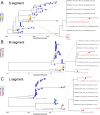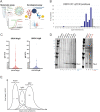Oropouche virus as an emerging cause of acute febrile illness in Colombia
- PMID: 36239235
- PMCID: PMC9639516
- DOI: 10.1080/22221751.2022.2136536
Oropouche virus as an emerging cause of acute febrile illness in Colombia
Abstract
Arbovirus infections are frequent causes of acute febrile illness (AFI) in tropical countries. We conducted health facility-based AFI surveillance at four sites in Colombia (Cucuta, Cali, Villavicencio, Leticia) during 2019-2022. Demographic, clinical and risk factor data were collected from persons with AFI that consented to participate in the study (n = 2,967). Serologic specimens were obtained and tested for multiple pathogens by RT-PCR and rapid test (Antigen/IgM), with 20.7% identified as dengue positive from combined testing. Oropouche virus (OROV) was initially detected in serum by metagenomic next-generation sequencing (mNGS) and virus target capture in a patient from Cúcuta. Three additional infections from Leticia were confirmed by conventional PCR, sequenced, and isolated in tissue culture. Phylogenetic analysis determined there have been at least two independent OROV introductions into Colombia. To assess OROV spread, a RT-qPCR dual-target assay was developed which identified 87/791 (10.9%) viremic cases in AFI specimens from Cali (3/53), Cucuta (3/19), Villavicencio (38/566), and Leticia (43/153). In parallel, an automated anti-nucleocapsid antibody assay detected IgM in 27/503 (5.4%) and IgG in 92/568 (16.2%) patients screened, for which 24/68 (35.3%) of PCR positives had antibodies. Dengue was found primarily in people aged <18 years and linked to several clinical manifestations (weakness, skin rash and petechiae), whereas Oropouche cases were associated with the location, climate phase, and odynophagia symptom. Our results confirm OROV as an emerging pathogen and recommend increased surveillance to determine its burden as a cause of AFI in Colombia.
Keywords: Colombia; NGS; Oropouche; RT–PCR; acute febrile illness; bunyavirus; fever; serology.
Conflict of interest statement
No potential conflict of interest was reported by the author(s).
Figures





Similar articles
-
Newborns with microcephaly in Brazil and potential vertical transmission of Oropouche virus: a case series.Lancet Infect Dis. 2025 Feb;25(2):155-165. doi: 10.1016/S1473-3099(24)00617-0. Epub 2024 Oct 16. Lancet Infect Dis. 2025. PMID: 39423837
-
Co-Circulation of 2 Oropouche Virus Lineages, Amazon Basin, Colombia, 2024.Emerg Infect Dis. 2024 Nov;30(11):2375-2380. doi: 10.3201/eid3011.240405. Epub 2024 Oct 2. Emerg Infect Dis. 2024. PMID: 39356574 Free PMC article.
-
Oropouche infection a neglected arbovirus in patients with acute febrile illness from the Peruvian coast.BMC Res Notes. 2020 Feb 10;13(1):67. doi: 10.1186/s13104-020-4937-1. BMC Res Notes. 2020. PMID: 32041646 Free PMC article.
-
Oropouche Virus (OROV) in Pregnancy: An Emerging Cause of Placental and Fetal Infection Associated with Stillbirth and Microcephaly following Vertical Transmission.Viruses. 2024 Sep 9;16(9):1435. doi: 10.3390/v16091435. Viruses. 2024. PMID: 39339911 Free PMC article. Review.
-
(Re-)Emergence of Oropouche Virus (OROV) Infections: Systematic Review and Meta-Analysis of Observational Studies.Viruses. 2024 Sep 22;16(9):1498. doi: 10.3390/v16091498. Viruses. 2024. PMID: 39339974 Free PMC article.
Cited by
-
Oropouche fever fatalities and vertical transmission in South America: implications of a potential new mode of transmission.Lancet Reg Health Am. 2024 Sep 25;38:100896. doi: 10.1016/j.lana.2024.100896. eCollection 2024 Oct. Lancet Reg Health Am. 2024. PMID: 39381084 Free PMC article. No abstract available.
-
[Key clinical manifestations to differentiate Oropouche fever from dengue and other arboviral diseases: a living systematic reviewRevisão sistemática viva das manifestações clínicas da febre do Oropouche: características-chave para diferenciá-la da dengue e de outras arboviroses].Rev Panam Salud Publica. 2024 Nov 15;48:e136. doi: 10.26633/RPSP.2024.136. eCollection 2024. Rev Panam Salud Publica. 2024. PMID: 39555475 Free PMC article. Spanish.
-
Oropouche virus: A re-emerging arbovirus of clinical significance.IJID Reg. 2024 Sep 25;13:100456. doi: 10.1016/j.ijregi.2024.100456. eCollection 2024 Dec. IJID Reg. 2024. PMID: 39507390 Free PMC article. No abstract available.
-
Temporal and coevolutionary analyses reveal the events driving the emergence and circulation of human mamastroviruses.Emerg Microbes Infect. 2023 Dec;12(1):2217942. doi: 10.1080/22221751.2023.2217942. Emerg Microbes Infect. 2023. PMID: 37222427 Free PMC article.
-
Human outbreaks of a novel reassortant Oropouche virus in the Brazilian Amazon region.Nat Med. 2024 Dec;30(12):3509-3521. doi: 10.1038/s41591-024-03300-3. Epub 2024 Sep 18. Nat Med. 2024. PMID: 39293488
References
-
- Silva-Caso, W, Aguilar-Luis MA, Palomares-Reyes C, et al. . First outbreak of Oropouche fever reported in a non-endemic western region of the Peruvian Amazon: molecular diagnosis and clinical characteristics. Int J Infect Dis. 2019;83:139–144. - PubMed
-
- Batista PM, Andreotti R, Almeida PSd, et al. . Detection of arboviruses of public health interest in free-living new world primates (Sapajus spp.; Alouatta caraya) captured in Mato Grosso do Sul, Brazil. Rev Soc Bras Med Trop. 2013;46(6):684–690. - PubMed
MeSH terms
Supplementary concepts
LinkOut - more resources
Full Text Sources
Other Literature Sources
